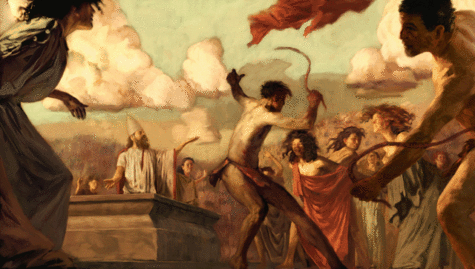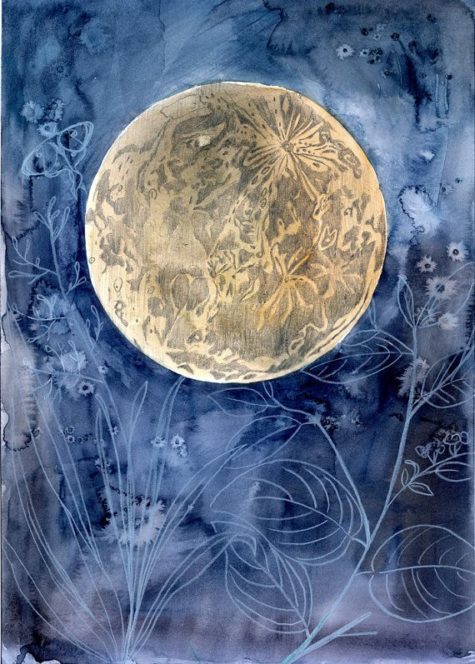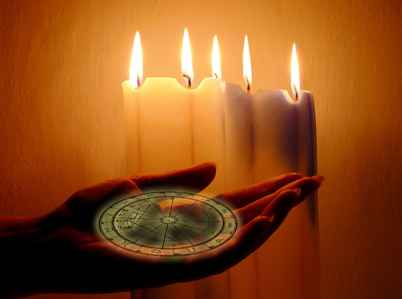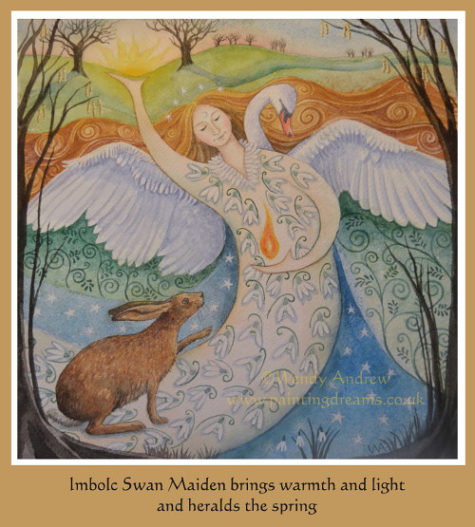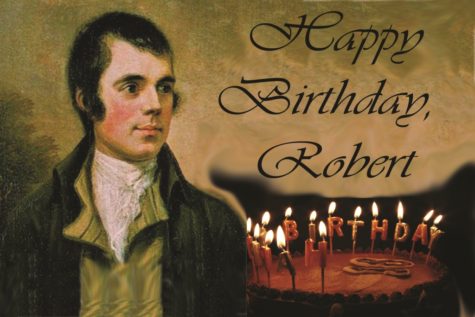Lupercalia is uniquely Roman, but even the Romans of the first century were at a loss to explain exactly which deity or deities were being exalted. It hearkens back to the days when Rome was nothing more than a few shepherds living on a hill known as Palantine and was surrounded by wilderness teeming with wolves.
Lupercus, protector of flocks against wolves, is a likely candidate; the word lupus is Latin for wolf, or perhaps Faunus, the god of agriculture and shepherds. Others suggest it was Rumina, the goddess whose temple stood near the fig tree under which the she-wolf suckled Romulus and Remus. There is no question about Lupercalia’s importance. Records indicate that Mark Antony was master of the Luperci College of Priests. He chose the Lupercalia festival of the year 44BC as the proper time to offer the crown to Julius Caesar.
February occurred later on the ancient Roman calendar than it does today so Lupercalia was held in the spring and regarded as a festival of purification and fertility. Each year on February 15, the Luperci priests gathered on Palantine Hill at the cave of Lupercal. Vestal virgins brought sacred cakes made from the first ears of last year’s grain harvest to the fig tree. Two naked young men (called Lupercii) asisted by the Vestals, sacrificed a dog and a goat at the site. The blood was smeared on the foreheads of the young men and then wiped away with wool dipped in milk.
The Lupercii them skinned the sacrificed goat and ripped the hide into strips which they tied around their naked waists and led groups of priests around the pomarium, the sacred boundary of the ancient city, and around the base of the hills of Rome. The occasion was happy and festive.
They then got drunk, and ran around Rome striking everyone they met with strips of the goat hide. This act supposedly provided purification from curses, bad luck, and infertility. Young women who were touched in this manner were thought to be specially blessed, especially in regards to fertility and procreation.
It is from these implements of purification, or februa, that the month of February gets its name.
Long after Palentine Hill became the seat of the powerful city, state and empire of Rome, the Lupercalia festival lived on. Roman armies took the Lupercalia customs with them as they invaded France and Britain. One of these was a lottery where the names of available maidens were placed in a box and drawn out by the young men. Each man accepted the girl whose name he drew as his love – for the duration of the festival, or sometimes longer.
Lupercalia, with its lover lottery, had no place in the new Christian order. In the year 496 AD, Pope Gelasius did away with the festival of Lupercalia, citing that it was pagan and immoral. He chose Valentine as the patron saint of lovers, who would be honored at the new festival on the fourteenth of every February. The church decided to come up with its own lottery and so the feast of St. Valentine featured a lottery of Saints. One would pull the name of a saint out of a box, and for the following year, study and attempt to emulate that saint.
If you are interested, you can read more about Valentine’s Day (and how it came to be what it is today) on it’s own separate page.
A modern approach to the Lupercalia is as follows:
- Themes: Love; Passion; Romance; Sexuality
- Symbols: Doves; Flowers; Berries; Trees; Pine Cones
- Presiding Goddess: Venus
About Venus:
Venus was originally an Italic goddess of blossoms; hearts and flowers have slowly become attributed to her loving, passionate energies. In fact, her name became the root for the word venerate – to lift up, worship, or esteem. So it is that Venus greets pre-spring efforts for uplifting our hearts with positive relationships.
To Do Today:
During Lupercalia, an ancient predecessor of Valentine’s Day, single girls put their names in a box, and unmarried men drew lots to see with whom they would be paired off for the coming year. To the more modern minded, try pinning five bay leaves to your pillow instead to dream of future loves. If you’re married or otherwise involved, steep the bay leaves in water and drink the resulting tea to strengthen the love in your relationship.
To encourage balance in a relationship, bind together Venus’s symbols, a pine cone and a flower, and put them somewhere in your home. Or, to spice up a passionate moment, feed fresh berries to each other and drink a berry beverage from one cup (symbolizing united goals and destinies).
In Roman tradition, anywhere there’s a large stone adjacent to a tall tree, Venus is also there. Should you know of such a place, go there today and commune with her warm lusty energy.
Sources:
The lunar eclipse is the symbol of the Crone, also called Hecate, Hel, Mother Hulda, the Snow Queen, Bone Mother, Demeter (when searching for Persephone and the earth’s vegetation dies) and Sekhmet. It is significant that the eclipse does not related to the Crone as Lady of Wisdom, who is part of the Crone image with the waning crescent-moon part of the lunar cycle, but focuses on the Lady as Passage. Now is a fine time for Dark magic and Sidhe magic.
The Lady as Passage offers transit between the worlds to Otherworld and the Sidhe, and her moon is the best time for magic involving Other People, or for seeking a companion from the Otherworld.
This lunar event additionally provides a person with the opportunity of drawing the subconscious, intuitive mind, which draws upon the Goddess as Transformer. She is the Dark Lady of the subconscious, intuitive mind, who then transforms the practitioner’s innate desire/will into reality as She Herself changes into the Mother. She gives birth to your desire in a ritual or meditation.
You focus on what it is you want, and as the Moon passes into darkness, envision the desire being gathered by the Crone, then passed into the arms of the Maiden as the sliver of Moon appears heralding the ending of the eclipse, and brought into manifestation by the Mother as the Moon is finally revealed.
From: Green Witchcraft II
The full moon in February is known as the Quickening moon, it marks the official end of winter, and the quickening, the renewal of all things. While the skies are still gray, and the weather is cold, beneath the surface life begins to secretly stir.
This moon phase is a time of abundance, ripening and completeness, heavy with fertility and female divinity. It is a time when the potential of all things begins to stir towards birth in spring, a time to work on our own inner power and confront personal truths in preparation for birth. This moon sheds enough light to help us see into our darkness, so that our energy can make its way to the surface to prepare for growth and healing.
This is the season of Imbolc, the days when we know that if we can just hold on for a few more weeks, we might get lucky and see little green shoots peeking out through the snow and slush.
Correspondences:
- Colors: Purple and blue
- Gemstones: Rose quartz, amethyst, jasper
- Trees: Rowan, Myrtle
- Gods: Brighid, Aphrodite, Juno, Mars
- Herbs: Hyssop, sage, myrrh
- Element: Fire
The word Quickening is also used to describe the first moment in pregnancy when a woman feels the movements of her baby. So too, this a time when new life is beginning, but still lies dormant. Pregnant animals, due in the spring, begin to feel the quickening of their unborn young. The earth itself is quickening, as seeds and bulbs far beneath the soil begin their journey towards the light. We know these things are coming — and we know also that this is a good month to make plans for the future. We can dream and hope, and set goals for ourselves. Accept responsibility for mistakes you’ve made in the past, and move on.
Magical workings this month should focus on personal achievements and advancement. This is an excellent time for fertility and childbirth spells.
From various sources
It’s no accident that Groundhog Day and Candlemas are celebrated together, for both signify the triumph of light over darkness, spring over winter. Candlemas was originally a Celtic festival marking the “cross-quarter day,” or midpoint of the season. The Sun is halfway on its advance from the winter solstice to the spring equinox.
Candlemas is the Christianized name for Imbolc, and all of the church candles are blessed for the year. The Virgin Mary is also honored. Today, this holiday is chiefly connected to weather lore. Even our American calendar keeps the tradition of Groundhog Day, a day to predict the coming weather. The Groundhog Day tradition tells us that if the Groundhog sees his shadow, there will be six more weeks of bad weather. An old British rhyme instructed:
If Candlemas day be fair and bright,
Winter will have another flight.
If Candlemas day be shower and rain,
Winter is gone and will not come again.
We pagans see the God as an infant during the time of Imbolc, and he is nursing from the Goddess and growing in power. It is the time for banishing Winter. We gather together the greens that adorned our homes during the Yule, and then we add these greens to the Imbolc fire. We chant and dance saying “We banish Winter! We welcome Spring!”
We light candles in each window and let them burn throughout the night. It is also an appropriate time for dedicating yourself to the Pagan path and purifying your home. You can also make candles for the coming year and consecrate new ritual items.
The Christian church expanded this festival of light to commemorate the purification of the Virgin Mary and her presentation of the infant Jesus in the Temple. Candlelit processions accompanied the feast day.Since the traditional Candlemas celebration anticipated the planting of crops, a central focus of the festivities was the forecasting of either an early spring or a lingering winter.
Sunshine on Candlemas was said to indicate the return of winter. Similarly:
“When the wind’s in the east on Candlemas Day
There it will stick till the second of May.”
A bear brought the forecast to the people of France and England, while those in Germany looked to a badger for a sign. In the 1800s, German immigrants to Pennsylvania brought their Candlemas legends with them. Finding no badgers but lots of groundhogs, or woodchucks, there, they adapted the New World species to fit the lore. Today that lore has grown into a full-blown festival, with Punxsutawney Phil presiding. For all things groundhog, visit the folks at Punxsutawney and see what Phil is predicting this year.
Sources: Almanac.com and Rose Ariadne
Celebrated on February 2nd, Imbolc or Imbolg, (pronounced “IM-bulk” or “EM-bowlk”), also called Oimealg, (“IM-mol’g), by the Druids, is the festival of the lactating sheep. It is derived from the Gaelic word “oimelc” which means “ewes milk”. Herd animals have either given birth to the first offspring of the year or their wombs are swollen and the milk of life is flowing into their teats and udders.
It is the time of Blessing of the seeds and consecration of agricultural tools. It marks the center point of the dark half of the year. It is the festival of the Maiden, for from this day to March 21st, it is her season to prepare for growth and renewal. Brighid’s snake emerges from the womb of the Earth Mother to test the weather, (the origin of Ground Hog Day), and in many places the first Crocus flowers began to spring forth from the frozen earth.
The Maiden is honored, as the Bride, on this Sabbat. Straw Brideo’gas (corn dollies) are created from oat or wheat straw and placed in baskets with white flower bedding. Young girls then carry the Brideo’gas door to door, and gifts are bestowed upon the image from each household. Afterwards at the traditional feast, the older women make special acorn wands for the dollies to hold, and in the morning the ashes in the hearth are examined to see if the magic wands left marks as a good omen.
Brighid’s Crosses are fashioned from wheat stalks and exchanged as symbols of protection and prosperity in the coming year. Home hearth fires are put out and re-lit, and a besom is place by the front door to symbolize sweeping out the old and welcoming the new. Candles are lit and placed in each room of the house to honor the re-birth of the Sun.
Another traditional symbol of Imbolc is the plough. In some areas, this is the first day of ploughing in preparation of the first planting of crops. A decorated plough is dragged from door to door, with costumed children following asking for food, drinks, or money. Should they be refused, the household is paid back by having its front garden ploughed up.
In other areas, the plough is decorated and then Whiskey, the “water of life” is poured over it. Pieces of cheese and bread are left by the plough and in the newly turned furrows as offerings to the nature spirits. It is considered taboo to cut or pick plants during this time.
As with all the Sabbats it is a time to celebrate the changes in the land around us. It is important to be outside to see, feel, smell, and appreciate the way that nature is changing, to pay our respects to the Gods and to seek their guidance for the coming season.
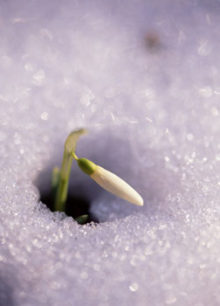 You can either take a walk to a favorite place, where you will be able to appreciate the changes around you, or as this is a time of new beginnings, it can be interesting to take a new route. Whichever your choice, take with you a small amount of spring water, or collected rain water. As you go, take care to notice the signs of new life and growth and wherever you see new shoots, buds, or leaves sprinkle a few drops on the plant and give thanks to the Goddess.
You can either take a walk to a favorite place, where you will be able to appreciate the changes around you, or as this is a time of new beginnings, it can be interesting to take a new route. Whichever your choice, take with you a small amount of spring water, or collected rain water. As you go, take care to notice the signs of new life and growth and wherever you see new shoots, buds, or leaves sprinkle a few drops on the plant and give thanks to the Goddess.
If you should come across a well or a spring, take the time to make an offering to the waters within. If you have finished the water you brought then your offering should be something which will not contaminate the water in any way. Where a tree grows close to this water you can also tie a single hair to one of its branches and ask for a Blessing for yourself or someone close to you.
If you should be lucky enough to pass grazing land look out for the first lambs of the year. If you see your first lamb of the year on this day you can make a wish.
As this is a time of new life and growth, it is appropriate to plant bulbs or flowers or to sow seeds. However, you will need to use your judgement and some local knowledge to decide whether to actually do so at Imbolc or whether to wait a week (or several) until the last frosts have passed. Of course seeds can often be started indoors and planted out a month or so later.
A word of caution here – if you are unlucky and your seedlings or plants fail, try not to read anything ‘significant’ into this. Unless and until you are an experienced and seasoned gardener, or unless you naturally have ‘green fingers’ you are quite likely to have a less than impressive success rate the first few times.
If you don’t have access to a garden, you can always choose an indoor plant to nurture. Many of the herbs that Witches use in their Magic, as well as their kitchen, will grow quite happily on a window sill. Rosemary and lavender are perhaps the two most useful, as well as having a pleasant scent all year round.
Celebrating Imbolc can be as easy as saying a prayer or as complicated as doing an elaborate ritual. The thing to remember is that it be meaningful and done with intent. Remember also that the Imbolc season runs through the actual day of Imbolc until the Spring Equinox; if you miss the exact day, you haven’t missed out on celebrating. The following is a list of activities to do alone, with a partner, or with your child to honor nature and deity as we travel ever closer to spring. Continue reading
In Celtic times the day was considered to begin at dusk the preceding night, so all major celebrations would commence the night before the day of the festival, much as New Year festivities start on New Year’s Eve.
Also called Imbolg, Oimelc and Candlemas, this is the festival of Bride or Bridget. It celebrates the Goddess’s transformation from Crone to Maiden and heralds the coming Spring and the change from dark to light. One of the ways to celebrate this is with a Circle of lights.
The dates given for this sabbat vary. On some calendars it is given as Feb 1st and on others Feb 2nd. I think the confusion might possibly stem from this practice of commencing the celebration the night before.
Everyone gathers in a Circle, lit only by a single black candle; the wick should be trimmed to give the smallest of flames. Each person has an unlit white candle. When everyone is ready someone says:
“This is the festival of Imbolg and the first signs of returning life tell us that Spring is on its way.
Let us light the path for the new season and say farewell to the old.
Blessed Be.”
They light their white candle from the black one, state something they wish for in the coming season, and extinguish the black candle. Going around the group Deosil (clockwise), each person states their own hopes and lights their candle from that of the person next to them. When all the candles are lit, everyone says together:
“We welcome the Goddess as Maiden,
We welcome the signs of new life.
We welcome the coming Spring.”
The candles can be placed somewhere safe to burn whilst everyone enjoys a feast or, if this is not a family celebration, they may be extinguished and taken home to bring Spring into everyone’s homes.
From: The Real Witches’ Year
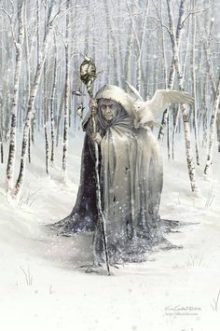 Là Fhèill Brìghde is the day the Cailleach gathers her firewood for the rest of the winter. Legend has it that if she intends to make the winter last a good while longer, she will make sure the weather on February 1 is bright and sunny, so she can gather plenty of firewood to keep herself warm in the coming months. As a result, people are generally relieved if February 1 is a day of foul weather, as it means the Cailleach is asleep, will soon run out of firewood, and therefore winter is almost over.
Là Fhèill Brìghde is the day the Cailleach gathers her firewood for the rest of the winter. Legend has it that if she intends to make the winter last a good while longer, she will make sure the weather on February 1 is bright and sunny, so she can gather plenty of firewood to keep herself warm in the coming months. As a result, people are generally relieved if February 1 is a day of foul weather, as it means the Cailleach is asleep, will soon run out of firewood, and therefore winter is almost over.
Visit The Powers That Be for more information about the Cailleach,
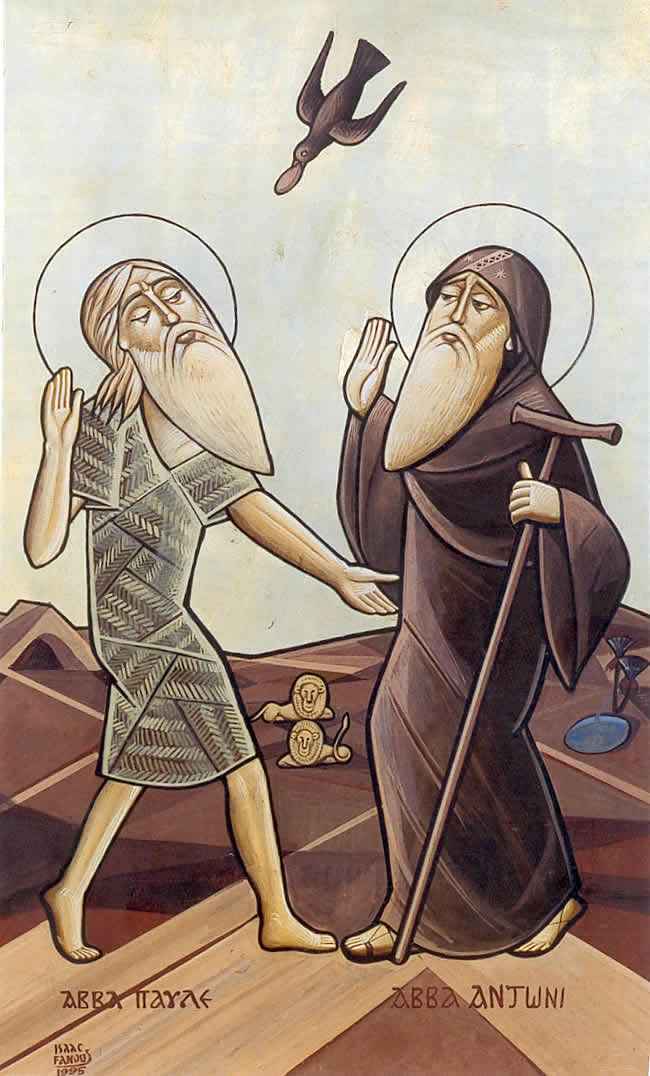 January 25 is St. Paul’s day, a festival of the Roman and English churches in commemoration of St. Paul. This day is thought to be prophetic as to the weather of the year:
January 25 is St. Paul’s day, a festival of the Roman and English churches in commemoration of St. Paul. This day is thought to be prophetic as to the weather of the year:
“If St. Paul’s day be fair and clear, It doth betide a happy year; If blustering winds do blow aloft. Then wars will trouble our realm full oft; And if it chance to snow or rain, Then will be dear all sorts of grain.”
In Germany when the day proved foul the common people used to drag the images of St. Paul and St. Urban in disgrace to duck them in the river.
- On the day of the conversion of St . Paul, (January 25th,) the four winds wrestle and the winner will blow most of the year. (Belgium.)
- If it rains on St. Paul’s day there will be plenty of mushrooms. (Bohemia.)
Other omens and folklore for St Paul’s day include the following:
- Fire will not burn a man born on St . Paul’s day, but if a woman who was born on that day is burned, the wound will never heal.
- Interestingly, in Sicily, it doesn’t matter what day you were born on – if you are a man fire will not burn you, but if you are a woman it will not only burn, it will eventually cause your death!
On a more positive note:
- If you set your hens to hatch on Paul’s day, they will become good layers.
Found in: Encyclopedia of superstitions, folklore, and the occult
January 25, the birthday of Scotland’s most famous poet, Robert Burns (1759-1796), has become an occasion for Scots all over the world to gather together in his honor. A Burns Night supper usually includes haggis, a traditional dish of the heart, lungs, and liver of a sheep or calf minced with suet, onions, oatmeal, and seasonings. Burns’s words: “Hail Great Chieftan o’ the Puddin-race!” greets the dish’s entry into the room. Men wear kilts and women their tartan sashes, and the evening’s celebration includes reading Burns’s poems and singing his songs, ending with one of his most famous, “Auld Lang Syne.
Found at Almanac.com
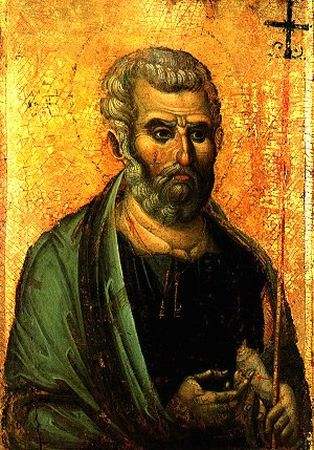 There are two feast days in the year which are dedicated to St Peter. January 16, and June 29 (which is the feast of Saints Peter and Paul). What follows is lore and superstition surrounding St Peter’s day:
There are two feast days in the year which are dedicated to St Peter. January 16, and June 29 (which is the feast of Saints Peter and Paul). What follows is lore and superstition surrounding St Peter’s day:
- No building should ever be begun on St . Peter’s day. It will never prosper.
- The Wallachians say that on St. Peter’s day all roads are guarded by serpents, and whoever kills one on that day will be lucky all the year.
- If it rains on St. Peter and St. Paul, there will be plenty of mushrooms.
- If you set your hens to hatch on Peter’s and Paul’s day, they will become good layers.
- Make nests for the hens on St . Peter’s day, And many ‘s the egg that they will lay.
Collected from various sources
